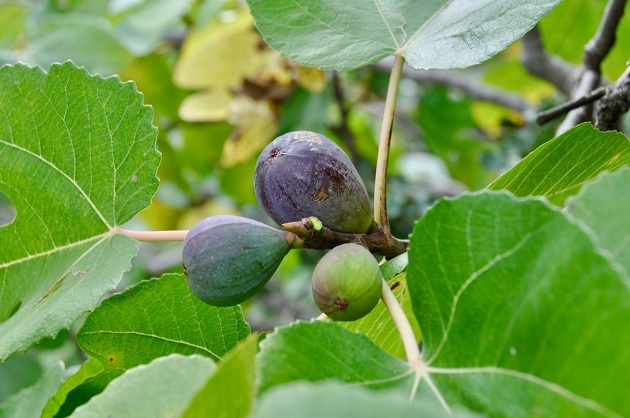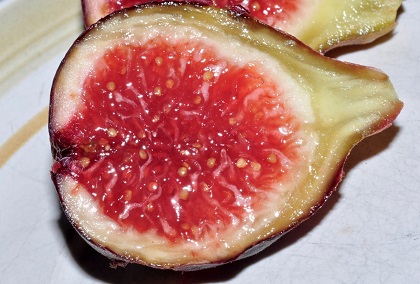Fig-trees appear more than forty times in the Bible, while the fruit of the tree is mentioned some twenty times.
 Photos: Antonio Cruz
Photos: Antonio Cruz
Then the eyes of both of them were opened, and they realized they were naked; so they sewed fig leaves together and made coverings for themselves. Genesis 3:7
Awareness of their own nakedness, according to Scripture, was what prompted Adam and Eve, our earliest human ancestors, to cover themselves with fig leaves. This is the first time that the fig tree is referred to in the Bible, but not the only time.
Fig-trees appear more than forty times, while the fruit of the tree is mentioned some twenty times (Num. 13:23, 20:5; Deut. 8:8; Psalm 105:33; Jeremiah 5:17; Joel 1:12; Mat. 21:19, 20, 21; 24:32; Mark 11:13, 20, 21; 13:28; Luke 13:6, 7; 21:29; John 1:48; James 3:12; Rev. 5:13).
The number and the significance of these references show to what extent this plant was an integral part of the daily lives of the Jewish people.
The Hebrew word for fig tree is teenah, while its fruit, figs, are te'enim (Judges 9:10; Num. 13:23, etc.) The tree is translated in the Greek Septuagint as sykon, and this is the word that is used for it in the New Testament (Mat. 7:16; Mark 11:13; Luke 6:44; James 3:12).
It is the botanical species Ficus carica (The term ficus in Latin is used to refer both to the tree and its fruit, while carica alludes to the region of Caria, where this fruit was particularly common).
 Photo: Antonio Cruz
Photo: Antonio CruzIn Bible lands, fig trees grew spontaneously, though there were also grown in plantations as their fruit was harvested twice. The first figs appeared in the spring, and were known as early figs (Jeremiah 24:2; Nahum 3:13).
These figs ripened in late spring thanks to the large leaves which protected them from the intense heat of the sun (Mark 11:13, Mat. 21:19; Luke 13:6-9). Later there might well be a second crop of ripe figs, this time green in colour, which were ready for picking between August and October, and were eaten fresh or dried.
They were also used to make a kind of cake of dried, pressed figs, very rich in calories (1 Samuel 25:18).
There are two types of fig-trees: those that bear fruit twice a year and those that bear fruit once a year. The former, as I have already mentioned, begin with the early figs in spring, which are formed during the course of the winter and ripen between May and June.
The second crop, which is usually more abundant, consists of real “figs” as we know them, ripens during the summer. The darker early figs always develop on the old wood of the previous year’s branches, while the green figs of the second crop develop on the current season’s new branches.
As well as being an excellent source of food, figs were also used for medical purposes, including creams and ointments for healing wounds and lesions (2 Kings 20:7; Isaiah 38:21).
Together with grapes and olives, they were the best known and most commonly consumed fruit in Israel, as they did not require any special care, and were abundant throughout all Mediterranean countries.
In botanical terms, the fig tree (Ficus carica) belongs to the moraceae family and originated in Southwest Europe. Now it grows wild around the Mediterranean basin and in other regions of the world. It is a deciduous tree which reaches a height of 8 metres and has a very open crown with large, spreading branches.
Sometimes the branches almost touch the ground. Its bark is smooth and greyish, while its leaves are large (25 by 18 cm), bright green, with a rough texture and numerous follicles (they can have as many as seven or eight follicles).
One of the most complicated aspects of the fig tree is its apparent lack of blossom. It never seems to flower. In fact, however, it does blossom, but the flowers (both male and female) are hidden inside some very small pear-shaped receptacles (syconiums), which subsequently become the figs themselves, which is why they can’t be seen.
Each of these receptacles has a small apical opening (ostiole). The tiny male flowers are distributed around the inside of this opening, while the female flowers are located deeper inside it.
The flowers are pollinated by small wasps known as Blastophaga psenes,[1], which have a symbiotic connection with the fig tree.
The small female hymenopterous insects enter through the miniscule ostiole, lay their eggs inside the flower and, after pollinating it, die. When the baby wasps are born, the males, which do not have wings, impregnate the females inside the ovary, and then also die without ever having left seen the light of day.
The fertilised female wasps leave the flower through the ostiole, bringing with them the pollen from the male flowers, which will, in turn, fertilise other figs. The little pink seeds inside the figs are, in fact, the real fruit of the fig.
Figs were among the first plants grown by humankind, dating from before the cultivation of wheat, barley or vegetables. Fossilised figs have been found in the Jordan valley which date back to the Neolithic period (9400 to 9200 years before Christ). [2]
In ancient Egypt, monkeys are also known to have been trained to climb the fragile branches of fig trees to pick the fruit. [3] Both the Greeks and the Romans appreciated the numerous benefits of trees, although they knew that the wood tends to rot and cannot even be used for firewood.
In the Old Testament, fig trees were a symbol of well-being, safety and prosperity. The times of peace of Solomon’s kingdom were characterised by “living safely, each one beneath his vine and fig-tree” (1 Kings 4:25; also see Micah 4:4; Zachariah 3:10).
By contrast, cutting down fig trees or shaking them violently to get their fruit was a negative symbol of divine punishment (Isaiah 34:4). Likewise, it was seen as a curse when the locust devoured its leaves (Amos 4:9) or stripped the branches of their bark (Joel 1:7, 12).
In the New Testament, the tree appears in relation to the call of Nathanial, to whom Jesus said, “before Philip called you, when you were sitting beneath the fig tree, I saw you” (John 1:48).
However, it also features as a symbol of the people of Israel, in emblematic passages such as the cursing of the sterile fig-tree (Mark 11:12-17), in which the presence of leaves and the lack of figs is likened to hypocritical, sterile religiosity.
The prophetic parable of the fig tree constitutes a vivid image of the destruction of Israel’s great institutions. Even though at the time of the Passover, in April, fig trees cannot bear figs, Jesus insists on looking for them in order to force this symbolic, teaching parable.
The tree that God had planted in Zion, the fertile, luxuriant Jerusalem of the promises, in fact has turned out to be hollow, fruitless, with nothing but indigestible religious foliage.
For more than two thousand years, God had been preparing his people through patriarchs, prophets, psalmists, kings and leaders, but in the end, lots of leaves and precious little fruit. This is also the danger that the church faces, maybe more now than ever.
NOTES
[1] https://es.wikipedia.org/wiki/Blastophaga_psenes
[2] Mordechai E. Kislev, Anat Hartmann, Ofer Bar-Yosef (2006). «Early Domesticated Fig in the Jordan Valley». Science 312 (6778): 1372-1374. doi:10.1126/science.1125910.
[3] “Monkeys Trained as Harvesters”. Natural History. Seen on 16 March 2019. «...Erman notes that fig trees have gnarled trunks, that they rarely attain more than sixteen feet in height, and that they have limbs too weak to sustain the weight of the gardeners. Hence people “send tame monkeys into the branches to gather the fruit for them.”».

Las opiniones vertidas por nuestros colaboradores se realizan a nivel personal, pudiendo coincidir o no con la postura de la dirección de Protestante Digital.
Si quieres comentar o